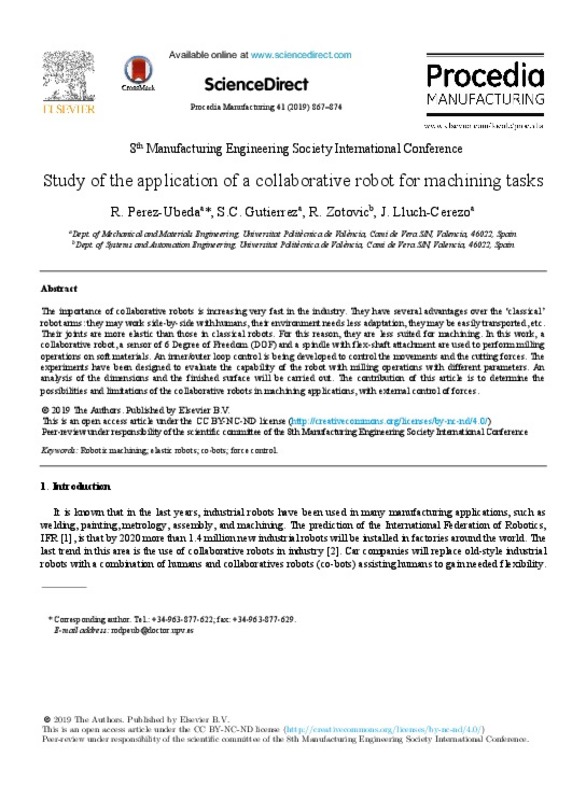JavaScript is disabled for your browser. Some features of this site may not work without it.
Buscar en RiuNet
Listar
Mi cuenta
Estadísticas
Ayuda RiuNet
Admin. UPV
Study of the application of a collaborative robot for machining tasks
Mostrar el registro sencillo del ítem
Ficheros en el ítem
| dc.contributor.author | Pérez-Ubeda, R.
|
es_ES |
| dc.contributor.author | Gutiérrez, S. C.
|
es_ES |
| dc.contributor.author | Zotovic Stanisic, Ranko
|
es_ES |
| dc.contributor.author | Lluch-Cerezo, J.
|
es_ES |
| dc.date.accessioned | 2021-02-02T04:32:02Z | |
| dc.date.available | 2021-02-02T04:32:02Z | |
| dc.date.issued | 2019 | es_ES |
| dc.identifier.uri | http://hdl.handle.net/10251/160414 | |
| dc.description.abstract | [EN] The importance of collaborative robots is increasing very fast in the industry. They have several advantages over the 'classical' robot arms: they may work side-by-side with humans, their environment needs less adaptation, they may be easily transported, etc. Their joints are more elastic than those in classical robots. For this reason, they are less suited for machining. In this work, a collaborative robot, a sensor of 6 Degree of Freedom (DOF) and a spindle with flex-shaft attachment are used to perform milling operations on soft materials. An inner/outer loop control is being developed to control the movements and the cutting forces. The experiments have been designed to evaluate the capability of the robot with milling operations with different parameters. An analysis of the dimensions and the finished surface will be carried out. The contribution of this article is to determine the possibilities and limitations of the collaborative robots in machining applications, with external control of forces. | es_ES |
| dc.description.sponsorship | The authors are grateful for the financial support of the Spanish Ministry of Economy and European Union, grant DPI2016-81002-R (AEI/FEDER, UE). This work was funded by the CONICYT PFCHA/DOCTORADO BECAS CHILE/2017 - 72180157 | es_ES |
| dc.language | Inglés | es_ES |
| dc.publisher | Elsevier | es_ES |
| dc.relation.ispartof | Procedia Manufacturing | es_ES |
| dc.rights | Reconocimiento - No comercial - Sin obra derivada (by-nc-nd) | es_ES |
| dc.subject | Robotic machining | es_ES |
| dc.subject | Elastic robots | es_ES |
| dc.subject | Co-bots | es_ES |
| dc.subject | Force control | es_ES |
| dc.subject.classification | INGENIERIA DE LOS PROCESOS DE FABRICACION | es_ES |
| dc.subject.classification | INGENIERIA DE SISTEMAS Y AUTOMATICA | es_ES |
| dc.title | Study of the application of a collaborative robot for machining tasks | es_ES |
| dc.type | Artículo | es_ES |
| dc.identifier.doi | 10.1016/j.promfg.2019.10.009 | es_ES |
| dc.relation.projectID | info:eu-repo/grantAgreement/CONICYT//2017-72180157/ | es_ES |
| dc.relation.projectID | info:eu-repo/grantAgreement/MINECO//DPI2016-81002-R/ES/CONTROL AVANZADO Y APRENDIZAJE DE ROBOTS EN OPERACIONES DE TRANSPORTE/ | es_ES |
| dc.rights.accessRights | Abierto | es_ES |
| dc.contributor.affiliation | Universitat Politècnica de València. Departamento de Ingeniería Mecánica y de Materiales - Departament d'Enginyeria Mecànica i de Materials | es_ES |
| dc.contributor.affiliation | Universitat Politècnica de València. Departamento de Ingeniería de Sistemas y Automática - Departament d'Enginyeria de Sistemes i Automàtica | es_ES |
| dc.description.bibliographicCitation | Pérez-Ubeda, R.; Gutiérrez, SC.; Zotovic Stanisic, R.; Lluch-Cerezo, J. (2019). Study of the application of a collaborative robot for machining tasks. Procedia Manufacturing. 41:867-874. https://doi.org/10.1016/j.promfg.2019.10.009 | es_ES |
| dc.description.accrualMethod | S | es_ES |
| dc.relation.publisherversion | https://doi.org/10.1016/j.promfg.2019.10.009 | es_ES |
| dc.description.upvformatpinicio | 867 | es_ES |
| dc.description.upvformatpfin | 874 | es_ES |
| dc.type.version | info:eu-repo/semantics/publishedVersion | es_ES |
| dc.description.volume | 41 | es_ES |
| dc.identifier.eissn | 2351-9789 | es_ES |
| dc.relation.pasarela | S\405477 | es_ES |
| dc.contributor.funder | European Regional Development Fund | es_ES |
| dc.contributor.funder | Comisión Nacional de Investigación Científica y Tecnológica, Chile | es_ES |
| dc.contributor.funder | Ministerio de Economía y Competitividad | es_ES |
| dc.description.references | International Federation of Robotics, IFR forecast: 1.7 million new robots to transform the world´s factories by 2020, IFR. (2017). https://ifr.org/ifr-press-releases/news/ifr-forecast-1.7-million-new-robots-to-transform-the-worlds-factories-by-20 (accessed February 15, 2019). | es_ES |
| dc.description.references | Robotic Industries Association (RIA), Top 6 Future Trends in Robotic Automation, RIA. (2018). https://www.robotics.org/blog-article.cfm/Top-6-Future-Trends-in-Robotic-Automation/101 (accessed May 6, 2019). | es_ES |
| dc.description.references | A. Grau, M. Indri, L. Lo Bello, T. Sauter, Industrial robotics in factory automation: From the early stage to the Internet of Things, in: Proc. IECON 2017 - 43rd Annu. Conf. IEEE Ind. Electron. Soc., 2017: pp. 6159–6164. doi:10.1109/IECON.2017.8217070. | es_ES |
| dc.description.references | Hui Zhang, Jianjun Wang, G. Zhang, Zhongxue Gan, Zengxi Pan, Hongliang Cui, Zhenqi Zhu, Machining with flexible manipulator: toward improving robotic machining performance, in: Proceedings, 2005 IEEE/ASME Int. Conf. Adv. Intell. Mechatronics., IEEE, 2005: pp. 1127–1132. doi:10.1109/AIM.2005.1511161. | es_ES |
| dc.description.references | Klimchik, A., Ambiehl, A., Garnier, S., Furet, B., & Pashkevich, A. (2017). Efficiency evaluation of robots in machining applications using industrial performance measure. Robotics and Computer-Integrated Manufacturing, 48, 12-29. doi:10.1016/j.rcim.2016.12.005 | es_ES |
| dc.description.references | Iglesias, I., Sebastián, M. A., & Ares, J. E. (2015). Overview of the State of Robotic Machining: Current Situation and Future Potential. Procedia Engineering, 132, 911-917. doi:10.1016/j.proeng.2015.12.577 | es_ES |
| dc.description.references | U. Robots, An introduction to common collaborative robot applications, White Pap. (2018) 18. https://info.universal-robots.com/common-collaborative-robot-applications (accessed September 23, 2018). | es_ES |
| dc.description.references | R. Perez, S.C. Gutierrez Rubert, R. Zotovic, A Study on Robot Arm Machining: Advance and Future Challenges, in: 29TH DAAAM Int. Symp. Intell. Manuf. Autom., 2018: pp. 0931–0940. doi:10.2507/29th.daaam.proceedings.134. | es_ES |
| dc.description.references | Chen, S., & Zhang, T. (2018). Force control approaches research for robotic machining based on particle swarm optimization and adaptive iteration algorithms. Industrial Robot: An International Journal, 45(1), 141-151. doi:10.1108/ir-03-2017-0045 | es_ES |
| dc.description.references | B. Siciliano, Robotics: Modelling, Planning and Control (2nd edition), 2010. doi:10.1007/978-1-84628-642-1. | es_ES |








